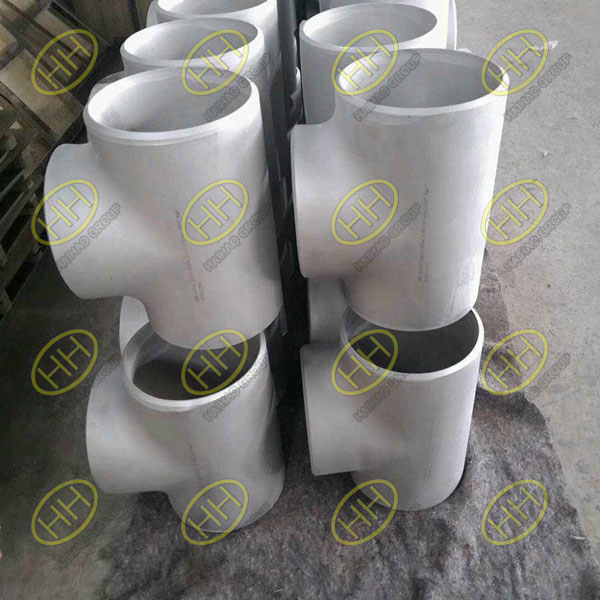Common Manufacturing Processes for Tees in Pipe Fitting Industry
Haihao Group recently completed the production of cold-extruded tees for an Iranian customer, strictly following the requirement for post-manufacturing heat treatment. This order highlights the importance of choosing the right forming process for tees, as different applications require different manufacturing techniques to ensure strength, durability, and performance.
In the pipe fitting industry, tees are produced using several forming processes, each with its own advantages. The most commonly used methods include cold extrusion, hot pressing, hydraulic bulging, and welding.

ASME B16.9 ASTM A403 WP304L equal tee
1.Cold Extrusion (Cold Forming Tees)
Process Overview:
A solid pipe is placed inside a die and subjected to high-pressure mechanical extrusion to form the branch outlet.
The material undergoes severe plastic deformation, increasing strength and density.
Advantages:
Higher mechanical strength due to work hardening.
Smooth internal surface with minimal material waste.
More precise dimensions compared to hot pressing.
Limitations:
Requires post-manufacturing heat treatment to relieve stress.
Not suitable for large-diameter or thick-walled tees.
Iranian Customer Order: The ASME B16.9 seamless tees supplied to our Iranian client were cold-extruded and underwent heat treatment to ensure mechanical stability and stress relief.
2.Hot Pressing (Hot Forged Tees)
Process Overview:
A pipe is heated to a high temperature and placed into a mold.
A punching tool expands the branch outlet while maintaining material integrity.
Advantages:
Ideal for large-diameter and high-wall-thickness tees.
Improves material ductility, reducing brittleness.
Suitable for high-pressure and high-temperature applications.
Limitations:
Requires precise temperature control to prevent cracks or deformation.
Higher energy consumption compared to cold extrusion.

SOCKET WELD EQUAL TEE A105 3000#
3.Hydraulic Bulging (Expansion Process for Seamless Tees)
Process Overview:
A high-pressure liquid (usually water or oil) is injected into the pipe.
The internal pressure expands the material, forming the branch outlet.
Advantages:
Creates a smooth and uniform grain structure.
Minimal welding or joint defects, enhancing reliability.
Best suited for small-diameter and thin-walled tees.
Limitations:
Not recommended for thick-walled tees due to material limitations.
Requires specialized equipment and longer production cycles.

ASME B16.9 A234 WPB equal tee
4.Welded Tees (Fabricated Tees)
Process Overview:
A separate branch pipe is welded onto the main run pipe.
The welding seams undergo non-destructive testing (NDT) for quality assurance.
Advantages:
Cost-effective for non-critical applications.
Suitable for custom sizes and special configurations.
Limitations:
Lower mechanical strength compared to seamless tees.
Welding seams require strict quality control to avoid defects.
Choosing the Right Manufacturing Process
The selection of the tee manufacturing process depends on several factors:
Material properties (carbon steel, stainless steel, alloy steel).
Application requirements (pressure, temperature, corrosion resistance).
Size and thickness of the tee.
At Haihao Group, we offer customized solutions for pipe fittings, ensuring that each product meets the highest industry standards. Our Iranian customer’s order is a perfect example of how we adapt our manufacturing techniques to meet specific performance and safety requirements.
Need high-quality tees for your project? Contact Haihao Group today for reliable and precision-engineered pipe fittings! Email:sales@haihaogroup.com

